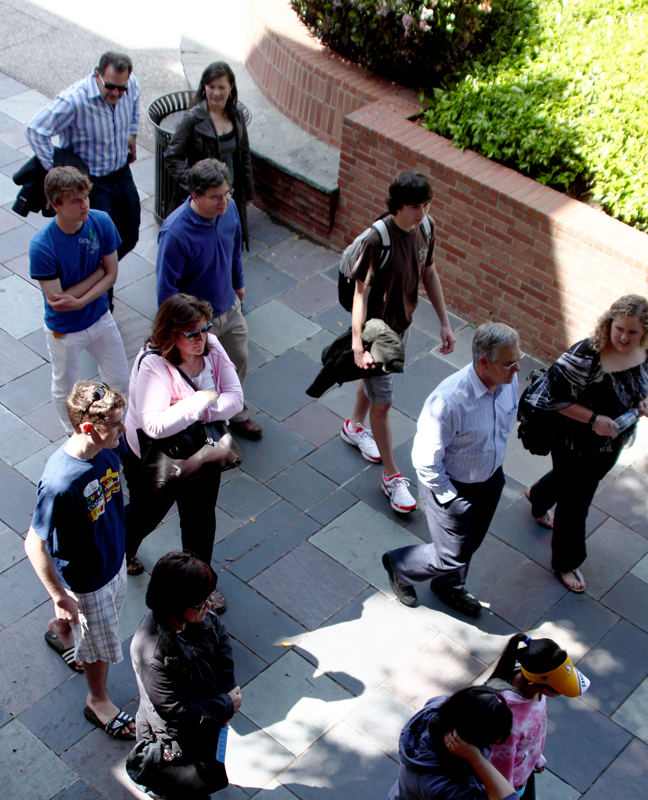For high school seniors, receiving mail from colleges in the spring means that the long wait is finally over.
But for UCLA officials, sending students the traditional fat envelopes is only the beginning.
UCLA has little trouble attracting prospective students ““ over 57,000 applied for admission this year. But once the university has chosen the 13,000 or so admits, the challenge is to convince them to enroll.
Yield activities, which include calling students and hosting large events like College Day, are the different strategies the university employs to achieve its targeted enrollment numbers.
These activities are designed primarily to draw students to the campus and then let the school sell itself, said Janina Montero, vice chancellor of Student Affairs.
“It’s important for us not to oversell the place,” Montero said. “The premise in yield is to provide an opportunity for students and families to see (UCLA), where they will be eating, what the student body looks like ““ to try to present as comprehensive a picture as possible.”
A new addition to this year’s yield activities is the Bruin Freshman Overnight Experience, a program that gives nonresident admits the chance to stay on the Hill with a student host.
UCLA implemented this program in response to the university’s need to expand the nonresident student population, said Rosa Pimentel, associate director of UCLA Undergraduate Admissions and Relations with Schools. An increase in non-California residents would help to mitigate the budget situation because they pay higher student fees, she said.
“For undergraduates, it’s a good experience to meet people from around the U.S.,” Pimentel said. “It enriches the classroom experience ““ they learn from us, you guys learn from them.”
The overnight program targets a group of students that tends to have lower enrollment rates: Nonresidents are farther from home and pay more. They are also likely to apply to Ivy League schools, increasing the competition for their Statement of Intent to Register, Pimentel said.
Additionally, some students who have applied to both UCLA and UC Berkeley ““ the university’s greatest competition for enrollment ““ receive a call from a Bruin representative, and can discuss questions and concerns they have about the school. Those who live in Los Angeles County receive a congratulatory letter from Mayor Antonio Villaraigosa, and Chancellor Gene Block phones 50 of the top admits.
However, for student athletes, the National Collegiate Athletic Association rules restrict the amount of interaction that can occur, said Mike Sondheimer, associate athletic director of academic admissions services. For example, recruiters can only call some athletes once a week.
But for groups like veterans, students with families and those who have been in the foster care system, UCLA has expanded its outreach, Pimentel said.
“Sometimes (these) people are shocked when they get admitted, but we tell them, “˜No, you have something very special, and the campus is going to work with you and be as sensitive as it can with your needs,'” Pimentel said, adding that these students receive calls and e-mails from the university.
Universities also benefit from yield activities that focus on getting admits to visit campus, said Linda DeAngelo, assistant director for research at the Higher Education Research Institute. Incoming college freshmen rank campus visits as one of the most important factors in their decision to attend a particular school, she said.
College Day, which runs April 5-16 this year, typically attracts the most students to campus along with the Academic Advancement Program’s Scholars Day, said Roxanne Neal, director of new student and transition programs. Both introduce students to the campus through workshops, Q-and-A sessions and other activities.
Tiffany Truong, a senior at Independence High School in San Jose, said UCLA’s bustling environment is one reason she is leaning toward becoming a Bruin rather than going to UC Berkeley.
“You don’t really know what it’s like until you come to campus,” Truong said. “You can watch the videos online and do research, but you can’t see stuff in concrete detail and look at everything. (Visiting UCLA), it seems like everybody has something to do.”
In particular, Truong said she liked the variety of clubs and activities.
Universities would also do well to create yield activities that involve alumni, DeAngelo said, because the success of a school’s graduates influences enrollment decisions. UCLA integrates alumni into College Day by having them greet students and families.
Next year, College Day and Scholars Day will be combined with other programs, such as one hosted by the School of Engineering and Applied Science, into a single event called Bruin Day that all admits can attend, Neal said. College Day is currently geared toward students in the College of Letters and Science, whereas other schools have separate events. Various ethnic groups on campus also have unique programs ““ for example, the Pilipino Recruitment and Enrichment Program puts on a four-day event for admits, Neal added.
“Right now, some of the yield work sort of stays below the radar screen,” Montero said. “There is value in the entire institution extending a welcome to the new students and families.”
However, the new structure could detract from the personal attention emphasized by individualized programs, said John Hamilton, the director of new student programs for the Academic Advancement Program.
“A more intimate setting, especially for historically underrepresented groups, low income students, first generation students, is a fit for us,” Hamilton said, naming the groups the program represents. “That’s the model we know, and we think it best serves students.”
